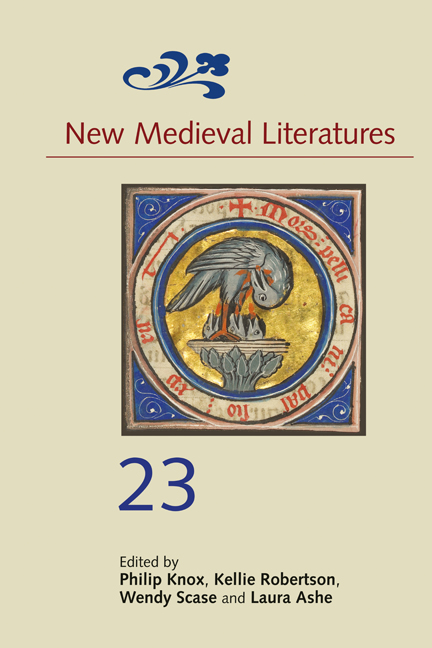Book contents
- Frontmatter
- Contents
- List of Illustrations
- Editors’ Note
- List of Abbreviations
- 1 A Paradox, (Un)Identified: Grendel’s Mother and the Lacanian Real
- 2 What Christ Might Say: Adapting the Last Judgment in the Prick of Conscience and Humbert’s De Dono Timoris
- 3 ‘At Jherusalem hyt ys goyd wyne’: The English Taste for the Sweet Blood of the Holy Land
- 4 The Bright Body: St Erkenwald’s Death Investigation
- 5 The Occasion of Chaucer’s Boece
- 6 ‘We axen leyser and espace’: Narrative Grace in Chaucer’s Franklin’s Tale and Melibee
- 7 The Shapes of the Speculum Christiani: Scribal Technique and Literary Aesthetics in Fifteenth-Century England
4 - The Bright Body: St Erkenwald’s Death Investigation
Published online by Cambridge University Press: 11 January 2024
- Frontmatter
- Contents
- List of Illustrations
- Editors’ Note
- List of Abbreviations
- 1 A Paradox, (Un)Identified: Grendel’s Mother and the Lacanian Real
- 2 What Christ Might Say: Adapting the Last Judgment in the Prick of Conscience and Humbert’s De Dono Timoris
- 3 ‘At Jherusalem hyt ys goyd wyne’: The English Taste for the Sweet Blood of the Holy Land
- 4 The Bright Body: St Erkenwald’s Death Investigation
- 5 The Occasion of Chaucer’s Boece
- 6 ‘We axen leyser and espace’: Narrative Grace in Chaucer’s Franklin’s Tale and Melibee
- 7 The Shapes of the Speculum Christiani: Scribal Technique and Literary Aesthetics in Fifteenth-Century England
Summary
Like all good detective stories, St Erkenwald begins with a dead body. The townspeople of seventh-century London stumble on a tomb no one has seen before. They call for their bishop, Erkenwald, but before he arrives, they open the lid, revealing a perfectly preserved, royally arrayed, and entirely unknown man. They comb their records and their memories for any sign of him, but are at a loss until Erkenwald arrives and miraculously returns the body to a ‘goste lyfe’ (line 192). The corpse itself testifies that he was a pagan judge who lived a blameless life before Christ, but that after burial, he lay unbaptized without decay under the church for centuries, suspended between death and judgment. Upon hearing this sad story, Erkenwald asks him to wait ‘as longe as I mygt lacche water | And cast vpon þi faire cors and carpe þes wordes’ (lines 316–17; until I might find water | And cast it upon thy fair corpse and say these words [of baptism]). But as the bishop speaks his plan, his tears fall upon the body. The judge suddenly reveals that the baptism has already been accomplished by Erkenwald's tears, and Erkenwald's accidental sacrament has already restored him to his proper place. In an instant, his body has decayed as it ought to have, and his soul is in heaven as it ought to be, and the good of pagan England is reclaimed.
St Erkenwald practically demands a historiographical reading. Its explicit project is to rehabilitate England's non-Christian past by unearthing the good in it and sublimating it into the Christian world. Facing the inconvenient fact that England had not always been Christian, the poem opens with the demolition and refounding of the churches of London to represent the conquest of the past in the name of the new Christian identity. Written during a politically unstable moment of Richard II's rocky reign, the poem makes a forceful argument for the longevity, durability, and essential Christianity of London, even before it was Christian. As a result, studies have dissected at length what Ruth Nissé calls its ‘strikingly anxious’ attitude towards historical discontinuities, examining its perspective on the strengths and failures of the historical archive, detailing the theory of history it proposes, and illuminating its attempt to wrest political and religious discontinuities into harmony with one another.
- Type
- Chapter
- Information
- New Medieval Literatures 23 , pp. 106 - 129Publisher: Boydell & BrewerPrint publication year: 2023

